Volume 63 (2008), 7
State
Abstrakt
The aim of the study is to analyze two basic stories of human freedom, that of Kant and that of Kierkegaard. In its first part the author tries to uncover the basic motives of both philosophical stories using the film Minority report as the background of his discussion. While according to Kant ethics is the basic manner of true self-under- standing,… Čítať ďalej
Abstrakt
Meister Eckhart’s theory of image is closely related to his doctrine of analogy and univocity. It is this linkage, which is highlighted in the article. The article brings several examples of analogical relationality and univocal correlationality which could be found in Eckhart himself and whose importance was recently emphasized in particular by Burkhard Mojsisch… Čítať ďalej
Abstrakt
The paper deals with the problem of representation on the background of J. Rancière’s political philosophy, in which he rejects the concept of the unrepresentable. The resolution of the problem follows from the confronting of two conceptions of the unrepresentable: that of the esthetics of the sublime in Kant and Lyotard and of the politics of prohibition in… Čítať ďalej
Abstrakt
J.-F. Lyotard described several transformations in art history and pointed out, that the motive power of contemporary art, i.e. modern and postmodern arts, is the sublime. What does this esthetical category mean, if not that to what the common concepts, such as inspiring, admirable, or the transcendent refer? The attention is paid to Kant’s articulation of the… Čítať ďalej
Abstrakt
The essay outlines a non-substantialist ontological conception of the work of art, which should grasp the process-like nature of the works of visual art. This process-like ontological model of the work of art draws on following conceptions: (a) the conception of the work of art as an experience in J. Dewey; (b) the conception of the virtual and actual existences… Čítať ďalej
